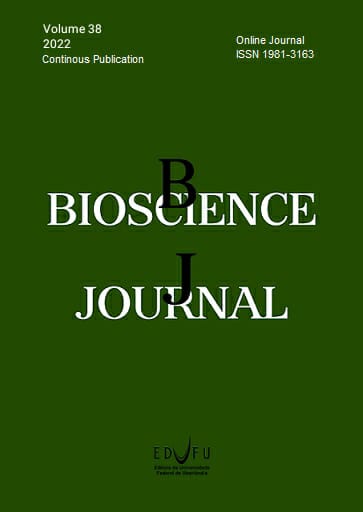Agronomic assessment of 32 sour passionfruit genotypes in federal district
DOI:
https://doi.org/10.14393/BJ-v38n0a2022-54231Keywords:
Genetic parameters, Passiflora edulis Sims, Productivity.Abstract
The production of passion fruit is important in Brazil. In order to contribute to the development of the most promising cultivars of passion fruit, this study aimed to evaluate the agronomic performance of 32 genotypes of passion fruit in Federal District of Brazil, and to estimate genetic parameters for use in breeding programs. Thirty-two genotypes were used in a randomized block design, with eight plants per plot and four replications. The experiment was conducted in field. Twenty-eight harvests were performed, and the variables analyzed were: productivity estimated, total number of fruits per hectare, average fruit weight and these characteristics following classification of fruits in five categories. The genotypes that presented the highest total yield estimated were MAR20 # 23, AR 01 and PLANTA 7. For industrial purposes, genotypes MAR 20 # 21 and BRS Gigante Amarelo were superior. For fresh consumption, the genotypes with the best performance were PLANT 7, AR 01 and MSC. Total productivity estimated and total number of fruits per hectare in the first-class classification showed high values of heritability and CVg/CVe ratio. These results indicate a favorable condition for selection.
References
CARDOSO, M.R.D., MARCUZZO, F.F.N. and BARROS, J.R. Classificação Climática de Köppen-Geiger para o Estado de Goiás e o Distrito Federal. Acta Geográfica. 2014, 8, 40-55. http://dx.doi.org/10.5654/acta.v8i16.1384
CAVALCANTE, N.R., et al. Productivity, fruit physicochemical quality and distinctiveness of passion fruit populations. Revista Brasileira de Fruticultura. 2016, 38(4), e-142. https://doi.org/10.1590/0100-29452016142
CRUZ, C.D., REGAZZI, A.J. and CARNEIRO, P.C. Métodos biométricos aplicados ao melhoramento genético. 4th ed. Viçosa, MG: Universidade Federal de Viçosa, Imprensa Universitária, 2012.
CRUZ, C.D. GENES: a software package for analysis in experimental statistics and quantitative genetics. Acta Scientiarum. Agronomy. 2013, 35(3), 271-276. https://doi.org/10.4025/actasciagron.v35i3.21251
DIAS, D.G., et al. Production and postharvest quality of irrigated passion fruit after n-k fertilization. Revista Brasileira de Fruticultura. 2017, 39(3), e-553. https://doi.org/10.1590/0100-29452017553
FALCONER, D.S. Introduction to quantitative genetics. Viçosa, MG: Universidade Federal de Viçosa, Embrapa Arroz e Feijão, 1987.
FALEIRO, F.G., et al. Germoplasma e melhoramento genético do maracujazeiro: histórico e perspectivas. Planaltina: Embrapa Cerrados, 2011. Available from Internet: https://ainfo.cnptia.embrapa.br/digital/bitstream/item/76032/1/doc-307.pdf
FALEIRO, F.G., et al. 2018. Avanços e Perspectivas do Melhoramento Genético de Passifloras no Brasil In: MORERA, M.P., et al. Maracujá: dos recursos genéticos ao desenvolvimento tecnológico. Brasília, DF: Embrapa Cerrados, pp. 85-95. Available from Internet: https://www.embrapa.br/en/busca-de-publicacoes/-/publicacao/1101174/maracuja-dos-recursos-geneticos-ao-desenvolvimento-tecnologico
FALEIRO, F.G. and JUNQUEIRA, N.T.V. Maracujá: 500 perguntas e 500 respostas. Brasília, DF: Embrapa Informação Tecnológica, 2016. Available from Internet: https://www.embrapa.br/en/busca-de-publicacoes/-/publicacao/1061917/maracuja-o-produtor-pergunta-a-embrapa-responde
GUERRA, N.B. and LIVERA, A.V.S. Correlação entre o perfil sensorial e determinações físicas e químicas do abacaxi cv. Pérola. Revista Brasileira de Fruticultura. 1999, 21(1), 32-35.
IBGE - Instituto Brasileiro de Geograria e Estatística. Produção Agrícola Municipal. 2018. Available from Internet: https://www.ibge.gov.br/estatisticas/economicas/agricultura-e-pecuaria/9117-producao-agricola-municipal-culturas-temporarias-e-permanentes.html?=&t=resultados
JESUS, C.A.S. de, et al. Fruit quality and production of yellow and sweet Passion fruits in northern state of São Paulo. Revista Brasileira de Fruticultura. 2012, 40(2), e-968. https://doi.org/10.1590/0100-29452018968
KOETZ, M., et al. Qualidade de frutos do maracujazeiro-amarelo em ambiente protegido e natural produzidos sob diferentes regimes de irrigação. Revista Brasileira de Agricultura Irrigada. 2010, 4(2), 115-126.
MELETTI, L.M.M. Avanços na cultura do maracujá no Brasil. Revista Brasileira de Fruticultura. 2011, 33, 83-91. https://doi.org/10.1590/S0100-29452011000500012
MOREIRA, H.S.M., et al. Agronomic characterization and genetic parameter estimation in yellow passion fruit. Bioscience Journal. 2018, 34(6), 58-70. https://doi.org/10.14393/BJ-v34n6a2018-39919
NOGUEIRA, I. Caracterização agronômica e fisíco-química de progênies de maracujazeiro azedo (Passiflora edulis Sims) no Distrito Federal. Brasília: Faculdade de Agronomia e Medicina Veterinária, Universidade de Brasília, 2016. Masters Dissertation.
PERUCH, L.A.M., COLARICCIO, A. and BATISTA, D.C. Controle de doenças do maracujazeiro: situação atual e perspectivas. Agropecuária Catarinense. 2018, 31(1), 37-40. https://doi.org/10.22491/RAC.2018.v31n1.2
PIMENTEL, L.D., et al. Seleção precoce de maracujazeiro pelo uso da correlação entre dados de produção mensal e anual. Pesquisa Agropecuária Brasileira. 2008, 43(10), 1303-1309. https://doi.org/10.1590/S0100-204X2008001000007
PIRES, M.M., JOSÉ, A.R.S. and CONCEIÇÃO, A.O. Maracujá: avanços tecnológicos e sustentabilidade. Ilhéus: Editus, 2011, pp. 237.
RANGEL, L.E.P. Desempenho agronômico de nove genótipos de maracujazeiro-azedo cultivados sob três níveis de adubação potássica no Distrito Federal. Brasília. Universidade de Brasília, 2002. Masters Dissertation.
SANTOS, C.L., et al. Relationship between yield and fruit quality of passion fruit c03 progenies under different nutritional levels. Revista Brasileira de Fruticultura. 2017, 39(2), e-691. https://doi.org/10.1590/0100-29452017691
SILVA, F.H.L., et al. Generating relevant information for breeding Passiflora edulis: genetic parameters and population structure. Euphytica. 2015, 208(3), 609–619. https://doi:10.1007/s10681-015-1616-8
SILVA, M.G.M., et al. Seleção recorrente intrapopulacional no maracujazeiro amarelo: Alternativa de capitalização de ganhos genéticos. Ciência e Agrotecnologia. 2009, 33(1), 170-176. https://doi.org/10.1590/S1413-70542009000100024
SILVA, M.G.M., et al. Biometria aplicada ao melhoramento intrapopulacional do maracujazeiro amarelo. Revista Ciência Agronômica. 2012, 43(3), 493-499.
VENCOVSKY, R. 1987. Herança quantitativa. In: PATERNIANI, E. and VIEGAS, G.P. (Eds.). Melhoramento e produção de milho no Brasil. Campinas: Fundação Cargil, pp. 137-214.
VIANA, A.P., et al. Implementing genomic selection in sour passion fruit population. Euphytica. 2017, 212(10), Article number 228. https://doi.org/10.1007/s10681-017-2020-3
ZACCHEO, P.V.C., et al. Production and qualitative characteristics of the fruits of yellow passion fruit hybrids. Revista Brasileira de Fruticultura. 2012, 34(4), 1113-1120. https://doi.org/10.1590/S0100-29452012000400019
Downloads
Published
Issue
Section
License
Copyright (c) 2022 Michelle Souza Vilela, José Ricardo Peixoto, Samara Dias Rocha Ramos , Rosa Maria de Deus de Sousa, Assussena Pereira de Oliveira, Marcelo de Abreu Flores Toscano , Antônio Alves de Oliveira Junior

This work is licensed under a Creative Commons Attribution 4.0 International License.





